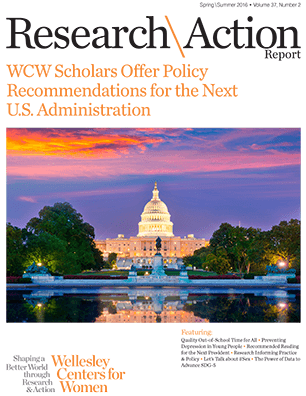Research Informing Practice & Policy
Sumru Erkut, Ph.D. and Ineke Ceder are presenting findings from the “Women in Theater Leadership Project” in Washington, D.C., during the National Conference of the Theatre Communications Group in late June. In 2013, the leadership of the American Conservatory Theater (ACT) in San Francisco, CA, and Sumru Erkut and Ineke Ceder, at the Wellesley Centers for Women, partnered to study gender equity in League of Resident Theatres (LORT) leadership. Women have not held more than 21 percent of artistic leadership and 38 percent of executive leadership in these theaters. After examining what is needed in a career profile to become a candidate for these positions and looking at the experiences of those aspiring to the positions, Erkut and Ceder, joined by ACT’s Associate Producer Erin Washington, will share research findings and recommendations on how to level the field for leadership in large theaters in the U.S., both along gender and racial backgrounds
In August 2016, Linda Charmaraman, Ph.D. will participate in the Mixed Methods International Research Association Conference to be held at Durham University, United Kingdom. The conference invited proposals under its theme, “Moving beyond the linear model: The role of mixed methods research in an age of complexity.” As a co-principal investigator, Charmaraman will be providing a methodological overview about recent work funded by the William T. Grant Foundation, in collaboration with Allison Tracy, Ph.D., senior research scientist, methodologist, and principal investigator. The talk is entitled, “Avoiding cultural bias in establishing program observation accuracy: Reflections on our evolving action-oriented mixed methods evaluation design,” which describes how the study began as a more traditional mixed method evaluation design with primarily a quantitative and qualitative, linear hypothesis-driven orientation (e.g., will raters improve in their program rating accuracy with different training enhancements over time?). The study program evolved into an action-oriented mixed method design that recursively used both quantitative and qualitative strands to continuously improve the online training system developed, after on-going consultation and feedback with stakeholders, community-based partners, and the study participants throughout the development and evaluation process.
Let’s Talk about #Sex by Jennifer Grossman, Ph.D.
Think about it—in many of our parents’ and grandparents’ generations, there was little family conversation about sex. Often, for religious and cultural reasons, family communication about sex was considered taboo. Many teens did not know what sex was or how to protect themselves from pregnancy or sexually transmitted infections (STIs). This has changed in many families, as cultural expectations have shifted and there is growing recognition that teenparent sexuality communication can protect teens from early pregnancy and STIs. Many parents also have reflected on the potentially harmful effects that ignorance about sexuality had on their own teenage years and lived experiences. Parents now often commit to talking with their children about sex, breaking from traditions of family silence from past generations, as a way to support their children’s healthy development.
by Ellen Gannett, M.Ed. and Elizabeth Starr, M.Ed., National Institute on Out-of-School Time
As expectations for high-quality afterschool and outof-school time (OST) programs continue to rise, a skilled, stable and committed OST workforce is critically important. Yet supports for youth workers, and resulting staff quality, remain uneven at best due in part to a highly fragmented landscape. Compensation remains stagnant and opportunities for professional advancement and public recognition remain practically non-existent.
By Tracy R.G. Gladstone, Ph.D., WCW associate director and senior research scientist, director of the Robert S. and Grace W. Stone Primary Prevention Initiatives
According to the World Health Organization, depression is the leading cause of disability worldwide—it is the most common psychiatric disorder in the U.S., and is particularly common among lower income populations, and among women beginning in adolescence. The average age of onset for depression is 15, and about 20 percent of all people will have experienced an episode of depression by the end of adolescence. Youth depression is associated with a host of negative and long-term consequences, including poorer school performance, difficult peer and family relationships, increased risk of substance abuse, and poorer functional outcomes in adulthood. Of particular note is the connection between youth depression and suicide. Although not all people who commit suicide were depressed at the time, depression and suicidal behavior are indeed linked. Suicide is a tremendous problem in the U.S. and is the second leading cause of death among American adolescents.
The March April 2016 issue of Women’s Review of Books (WRB) was quite different from the publication’s usual offering. Amy Hoffman, M.F.A., editor-in-chief, included a special section featuring WRB writers and some other favorite feminists sharing recommendations of what they thought the next U.S. president should be reading, in preparation for taking office. Additionally, Cartoon Editor Jennifer Camper illustrated the special section and added brevity with her artwork. The list that resulted is fascinating—and could probably keep even the most well-read person productively busy for the entire next presidential term. But it wasn’t quite what Hoffman expected.

In this issue:
 | Wellesley Centers for Women 781.283.2500 |
Copyright © 2025 Wellesley Centers for Women, Wellesley College | Privacy Policy
National SEED Project | National Institute on Out-of-School Time
